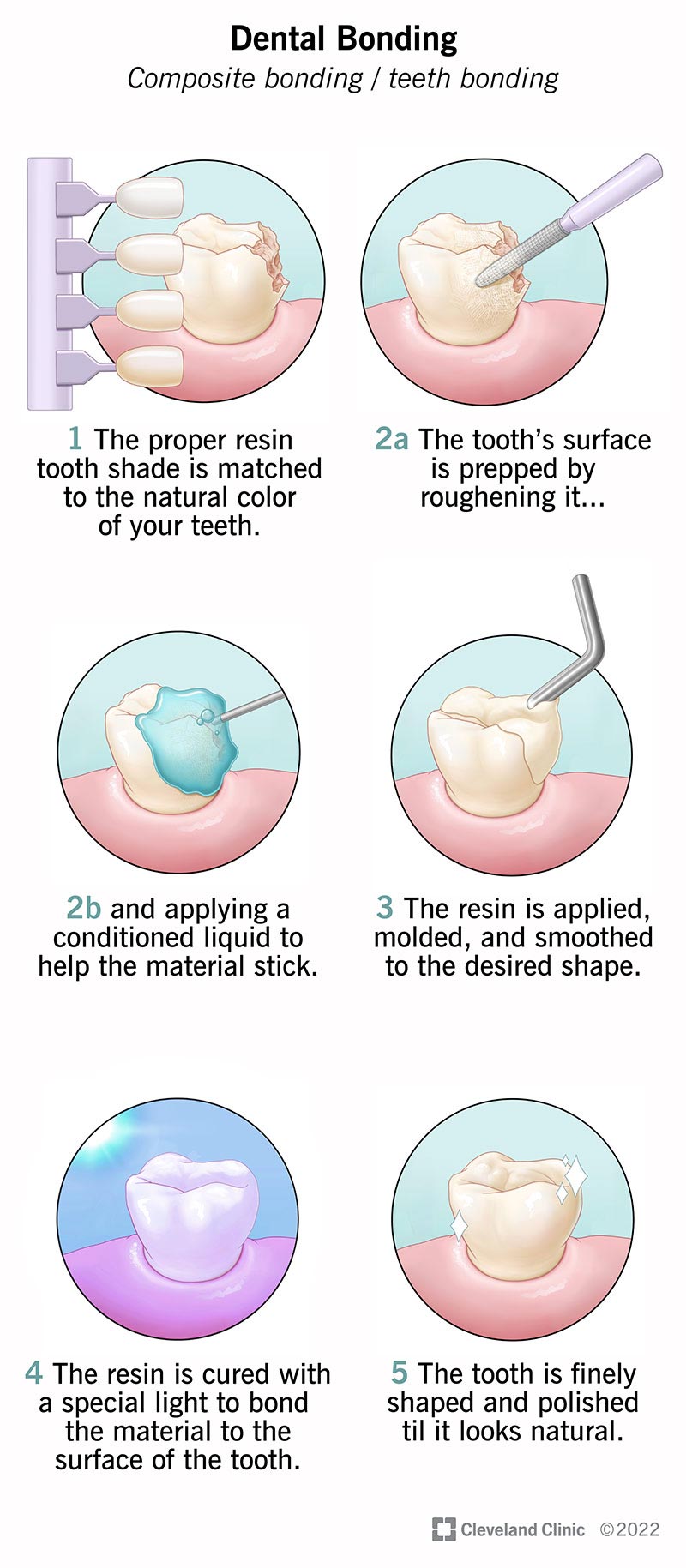Dental bonding is a cosmetic procedure that uses a tooth-colored composite resin material to enhance your smile. This procedure is used to repair chips, close down gaps or change the shape and color of a tooth. Unlike other cosmetic dental treatments, such as porcelain veneers, dental bonding is completely reversible.
Advertisement
Cleveland Clinic is a non-profit academic medical center. Advertising on our site helps support our mission. We do not endorse non-Cleveland Clinic products or services. Policy

Dental bonding, sometimes called composite bonding or teeth bonding, is a cosmetic dentistry treatment used to enhance your smile. During the procedure, your dentist applies tooth-colored resin material to the affected teeth to change their shape, size or color.
Advertisement
Cleveland Clinic is a non-profit academic medical center. Advertising on our site helps support our mission. We do not endorse non-Cleveland Clinic products or services. Policy
Dental bonding is used to make cosmetic improvements to your smile. The procedure uses tooth-colored composite resin material to:
The same composite resin material used in dental bonding is also used in restorative dentistry to:
Cosmetic dental bonding is very common. In fact, it’s one of the most frequently performed procedures in dentistry today.
Porcelain veneers are custom-made ceramic shells that adhere to the front surfaces of your teeth. To place them, your dentist typically must remove some enamel from your natural teeth. Once placed, porcelain veneers are not reversible. They’ll need replacing every 10 to 20 years.
Dental bonding, on the other hand, may not require significant enamel removal. As a result, bonding is completely reversible. You’ll likely need touchups every three to 10 years.
You might hear dentists use the term “composite veneers." This is when your dentist uses composite resin material to cover the entire surface of your tooth.
Advertisement
Prior to dental bonding, your dentist will sit down with you and discuss your cosmetic goals. They’ll also take dental X-rays and examine your teeth and gums to make sure you’re eligible for the procedure. If you have severe tooth decay, gum disease or other serious oral health problems, you’ll probably need to treat those issues first.
During your dental bonding procedure, your dentist will:
The procedure takes about 30 to 60 minutes per tooth to complete.
Dental bonding usually isn’t painful because your dentist won’t be working anywhere close to the pain-sensing nerve inside your tooth. In most cases, anesthesia isn’t even necessary during dental bonding. Some people may experience temporary sensitivity after their dental bonding procedure. Over-the-counter pain relievers can help ease this discomfort.
After dental bonding, proper oral hygiene is essential to keep your mouth healthy and bright. Brush at least twice a day with a soft toothbrush and fluoride toothpaste, and floss between your teeth once daily. In addition, you should visit your dentist regularly for check-ups and cleanings.
Cosmetic dental bonding offers many benefits compared to other cosmetic treatments. For example, the procedure is:
Although dental bonding material is somewhat stain-resistant, it doesn’t resist stains as well as porcelain restorations. Another disadvantage is that bonding isn’t as long-lasting as other restorative options, such as veneers or crowns. Also, bonding materials can chip over time.
Advertisement
In general, dental bonding is an excellent solution for making small cosmetic changes. If you’re looking for a more dramatic transformation, you may be better suited for other treatments, such as porcelain veneers.
Teeth bonding requires zero downtime. You’ll be able to resume all normal activities as soon as you leave your dentist’s office.
No. Simply follow good oral hygiene practices. Brush your teeth at least twice a day, floss at least once a day and see your dentist for regular check-ups and cleanings.
Because bonding material can chip, it is important to avoid habits like biting your fingernails, chewing on pens or using your teeth to open packages. If you notice any sharp edges on a bonded tooth or if your tooth feels odd when you bite down, call your dentist.
How long bonding materials last depends on several factors, such as your oral habits and how many teeth were treated. Typically, however, bonding material lasts between three and 10 years before needing to be touched up or replaced.
In general, dental bonding doesn’t pose any risks to your oral health. If you have healthy teeth and gums, then it’s perfectly safe.
However, if you have extensive tooth decay, gum disease or other serious issues affecting your oral health, you may need to have other treatments before pursuing dental bonding.
Advertisement
No. Because dental bonding doesn’t require enamel removal, it can be reversed at any time.
If you have chips, cracks, discoloration or other concerns about the way your teeth look, schedule an appointment with your dentist. They can talk with you about your cosmetic goals and design a personalized treatment plan to fit your needs.
If you’ve recently had cosmetic dental bonding, call your dentist if your bite feels "off." They can correct this issue during a quick appointment.
Cosmetic imperfections like chips, gaps, cracks or discoloration can detract from your smile and leave you feeling less confident. Dental bonding is a simple and effective treatment that can bring balance and uniformity to your smile. To find out if it’s right for you, talk to your dentist.
Advertisement
Dentistry plays an important role in oral health. Cleveland Clinic’s experts can design a personalized plan that will keep you smiling for the long haul.

Last reviewed on 04/14/2022.
Learn more about the Health Library and our editorial process.